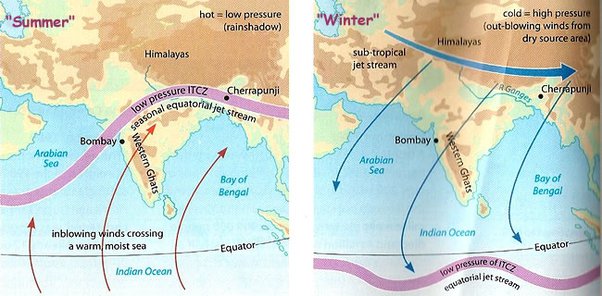Q. Discuss the mechanism of Indian Monsoon.
Ans: The Indian monsoon is a unique and complex weather phenomenon that brings seasonal rains to the Indian subcontinent. It plays a crucial role in shaping the region’s climate, agriculture, and overall ecosystem.

The mechanism of the Indian monsoon involves several interconnected factors:
- Differential Heating: The primary driving force behind the Indian monsoon is the differential heating of land and sea. During the summer months, the landmass of the Indian subcontinent heats up more quickly and intensely compared to the surrounding oceans.
- Low-Pressure System: The intense heating of the land creates a low-pressure area over the Indian subcontinent, particularly over northern and central India. This low-pressure zone acts as a vacuum, drawing in moist air from the surrounding oceans.
- Onset of Monsoon: As the land heats up, warm, moist air from the Indian Ocean begins to flow towards the low-pressure area over the land. This marks the onset of the monsoon season.
- Shift in Wind Patterns: During the monsoon, a shift in wind patterns occurs. The regular wind pattern, known as the trade winds, reverses its direction. The southwest monsoon winds, also known as the “summer monsoon,” blow from the southwest, bringing moisture-laden air from the Arabian Sea and the Indian Ocean.
- Arrival of Rainfall: As the southwest monsoon winds carrying moisture-laden air reach the Indian subcontinent, the warm, moist air is forced to rise due to the presence of the Western Ghats along the western coast and the Himalayas in the north. As the air rises, it cools and condenses, leading to the formation of clouds and rainfall.
- Rains and Distribution: The monsoon rains are heaviest along the western coast and gradually decrease as they move inland towards the northern and northeastern parts of the country. The rain-bearing clouds cover the entire subcontinent during the monsoon season.
- Retreat of Monsoon: Towards the end of the monsoon season, as the landmass starts cooling down, the low-pressure area weakens. The reverse wind pattern, known as the northeast monsoon or the “winter monsoon,” develops. Dry, cool air from the land flows towards the warmer Indian Ocean.
- Withdrawal of Monsoon: The withdrawal of the monsoon begins from the northwest and proceeds southward. The process is influenced by the retreating low-pressure system and the shift in wind patterns.
The Indian monsoon is not only influenced by local factors but also by larger global climate patterns, such as the El Niño and La Niña phenomena in the Pacific Ocean. These phenomena can lead to variations in the strength and distribution of the monsoon rains, affecting agricultural productivity and water resources.
Overall, the Indian monsoon is a complex interplay of land-sea temperature contrasts, wind patterns, topography, and atmospheric dynamics, creating a dynamic weather pattern that has a profound impact on the lives and livelihoods of people in the Indian subcontinent.
Thanks for reading the answer to the question: Discuss the mechanism of Indian Monsoon.
Read: